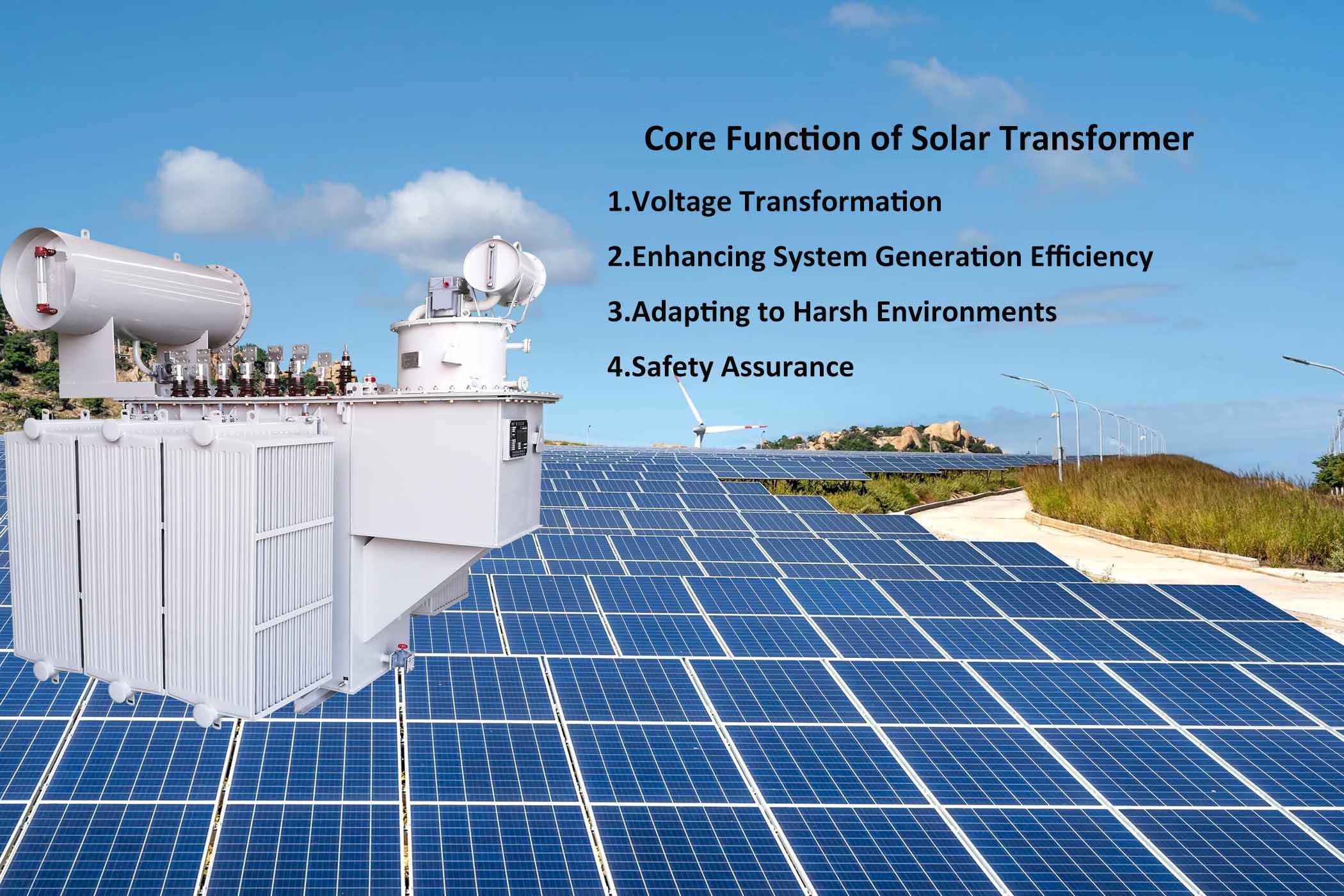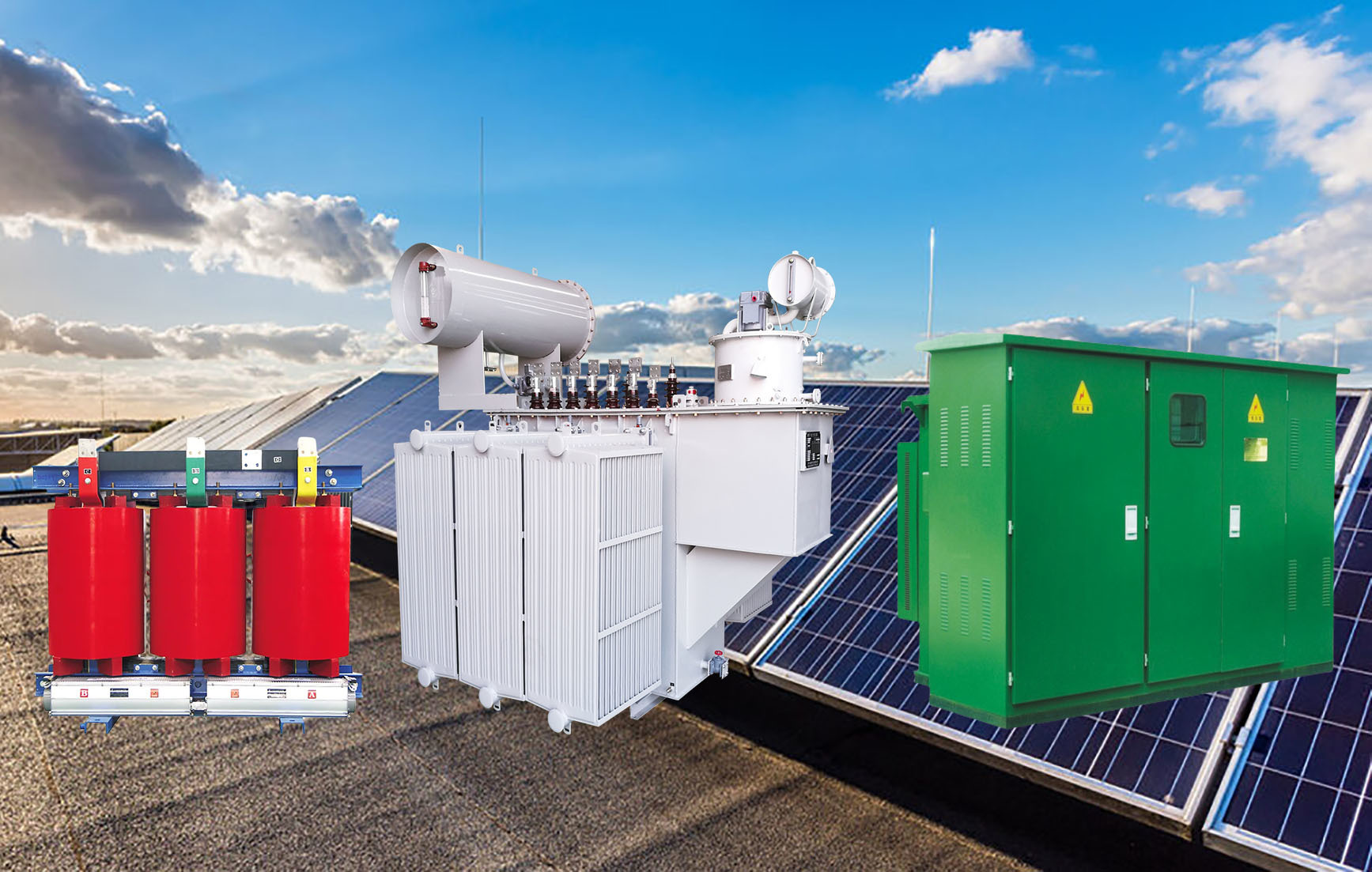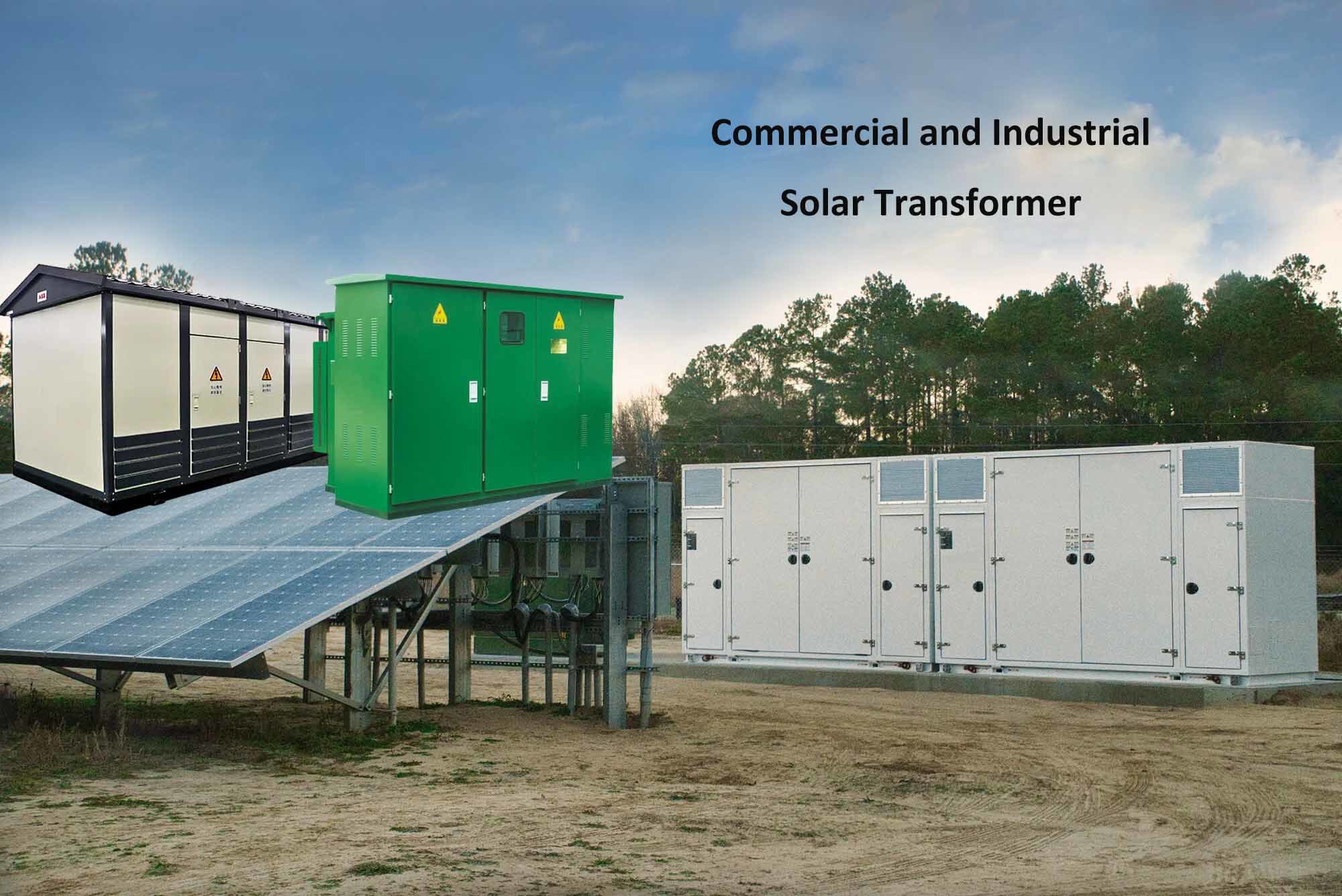Welcome to the official website of Luoyang AISITE Transformer Co., LTD
Commercial & Industrial Solar Transformer Selection Guide: Core Functions, Key Principles & Mainstream Types
Release time:
Aug 01,2025
Source:
In the rapidly growing commercial and industrial (C&I) solar sector, solar transformers play an indispensable core role. Far more than simple voltage conversion devices, they are critical hubs ensuring efficient transmission of solar energy, system stable operation, and overall safety. Selecting the right commercial and industrial solar transformer directly impacts the power plant's return on investment, long-term operational costs, and reliability. This guide delves into the functions of solar transformers, details selection principles, compares common types, and provides practical selection advice to help you find the optimal "energy bridge" for your PV system.
1. Core Functions of Commercial & Industrial Solar Transformers
In distributed photovoltaic (PV) systems, solar transformers undertake vital energy conversion tasks:
Voltage Transformation: The fundamental and most critical function. PV modules generate low-voltage direct current (DC) (typically hundreds of volts), while grid transmission or local high-power loads require high-voltage alternating current (AC) (e.g., 380V, 10kV, 35kV). Solar transformers step up the low-voltage AC output from inverters to voltage levels matching grid interconnection or load requirements, enabling efficient long-distance transmission or local consumption. For instance, most medium-to-large C&I plants need voltage boosted to 10kV or higher for public grid connection.
Enhancing System Generation Efficiency: High-quality solar transformer design significantly reduces copper and iron losses during energy transmission. Selecting high-efficiency transformers (e.g., meeting high-efficiency grades in GB 20052 or IEC 60076 standards) is an effective way to improve the overall PV system's energy yield.
Adapting to Harsh Environments: C&I applications vary (rooftops, factories, outdoors). Solar transformers must withstand challenges like high/low temperatures, humidity, salt spray, and dust. Dedicated solar transformers feature enhanced environmental adaptability for stable and reliable operation under diverse harsh conditions.
Safety Assurance: As crucial electrical nodes, transformer safety is paramount. Especially for widely used dry-type solar transformers, their excellent fire-proof, explosion-proof, and oil-free properties greatly reduce fire risks and environmental pollution, protecting personnel and assets.

2. Key Principles for Selecting C&I Solar Transformers
Scientific selection is fundamental for ensuring performance matching, cost-effectiveness, safety, and reliability. Focus on these dimensions:
2.1 Capacity Selection: Matching Power & Providing Margin
The solar transformer's rated capacity (kVA) must exceed the sum of the rated output capacities of all inverters connected to it. This accounts for potential inverter instantaneous overloads and harmonic currents, preventing transformer damage from prolonged overload or safety incidents.
Calculation Reference: Transformer Capacity ≥ (Total Inverter Rated Output Power (kW) / Power Factor (Typically 0.95-1)) * Margin Factor (Typically 1.1-1.25).
A *capacity margin (10%-25%)* is crucial for enhanced system reliability and facilitates future PV system expansion (adding modules/inverters), avoiding costly transformer replacement.
2.2 Voltage Level: Precise Grid Interconnection Matching
Rated voltage matching is prerequisite for grid connection. The transformer's high-voltage (HV) and low-voltage (LV) side ratings must strictly match the inverter output AC voltage and grid connection point voltage level.
*Low-Voltage Interconnection (e.g., 380V):* HV Side Voltage = 380V; LV Side Voltage = Inverter Rated Output Voltage (e.g., 270V, 315V).
*High-Voltage Interconnection (e.g., 10kV, 35kV):* HV Side Voltage = Grid Interconnection Voltage (e.g., 10kV); LV Side Voltage = Inverter Output Voltage (Common: 315V, 400V, 480V, 690V).
Voltage mismatch causes equipment malfunction, protection tripping, or damage.
2.3 Solar Transformer Type Selection: Determined by Environment & Needs
Dry-Type Solar Transformer:
Advantages: Oil-free, high fire/explosion-proof rating, eco-friendly, simpler maintenance, suitable for indoor installation (e.g., switchrooms). Typically use SCB10, SCB12, SCB13 or higher efficiency grades (e.g., SCB14 amorphous alloy, lower losses).
Disadvantages: Higher initial cost than oil-filled, slightly higher cooling requirements, larger size for high capacities.
Focus Areas: Cooling/ventilation, noise level (especially indoors), protection rating (IP), maintenance space.
Pad-Mounted Substation (Integrated):
Advantages: Highly integrated (transformer, HV/LV switchgear, metering), fast installation, saves civil works, ideal for outdoor use (rooftops, ground). High protection rating (typically IP33+).
Disadvantages: Higher overall cost, internal cooling needs special attention.
Focus Areas: Protection Rating (IP), Corrosion Resistance (Cx) (esp. coastal/industrial), internal temperature control, foundation requirements.
Liquid-Filled (Oil-Immersed) Solar Transformer:
Advantages: Mature technology, lower cost, excellent cooling, strong overload capability, suitable for large capacities.
Disadvantages: Oil leakage and fire risks, require fire separation & oil containment pits, high environmental impact, demanding maintenance (oil testing).
Scenario: Specific large ground-mounted plants or extremely cost-sensitive situations with strict fire safety compliance.
Special Types: Consider Splitting Solar Transformers (improves supply flexibility/reliability) or Two-Winding Transformers (specific voltage conversion/isolation needs) based on inverter specs and system requirements.
2.4 Losses & Efficiency: Focus on Total Cost of Ownership (TCO)
Choose low-loss, high-efficiency transformers (e.g., meeting National Grade 1 or 2 efficiency standards). While efficient transformers may cost more upfront, the electricity loss savings over a PV system's 20-25 year lifespan are substantial, resulting in lower Total Cost of Ownership (TCO).
Evaluate no-load losses (fixed) and load losses (variable) based on local electricity rates and load profiles.
2.5 Safety & Maintainability: Critical Factors
Safety: Prioritize transformers with robust fire, explosion, and moisture protection (dry-type excels). Ensure reliable overload protection, short-circuit protection, temperature control, and alarm systems.
Maintainability: Select well-designed, easy-to-maintain, easy-to-diagnose equipment. Consider supplier local service and spare parts availability to reduce O&M complexity and costs.
2.6 Vector Group Selection: Matching System Phasing
The Vector Group (e.g., Dyn11, Yyn0, YNd11) defines the transformer winding connection and phase relationship.
*Low-Voltage Interconnection (380V):* Commonly Dyn11. Dy = HV Delta connection, n = LV Star with neutral, 11 = LV line voltage lags HV line voltage by 30°. This connection suppresses 3rd harmonics and provides a neutral point.
*High-Voltage Interconnection (≥10kV):* Commonly YNd11 or Dyn11. Must be determined based on grid operator requirements, system earthing, and inverter output characteristics to ensure phase compatibility.
3. Comparison of Mainstream C&I Solar Transformer Types
The table below summarizes the core characteristics of three main solar transformer types for informed selection:
|
Type |
Core Characteristics |
Key Advantages |
Key Disadvantages |
Typical Application Scenarios |
|
Dry-Type Solar Transformer |
Oil-free, epoxy resin cast/vacuum impregnated, air-cooled |
Excellent fire/explosion proof, pollution-free, simple maintenance, suitable for indoor, eco-friendly |
Higher initial cost, larger size/weight for high capacity, cooling needs attention |
Modern C&I PV preferred choice, especially indoor switchrooms, high fire-safety locations (malls, factories) |
|
Pad-Mounted Substation |
Dry-type or oil-filled transformer + HV/LV switchgear etc. integrated in protective enclosure |
Rapid, convenient installation, saves civil works, *high protection (IP33+)*, ideal for outdoor, factory pre-tested |
Highest overall cost, internal cooling critical |
C&I rooftop distributed PV, ground-mounted distributed PV, outdoor projects lacking indoor space |
|
Liquid-Filled (Oil) Solar Transformer |
Core & windings immersed in insulating oil for cooling |
Mature tech, lower cost, excellent cooling, strong overload capacity |
Oil leak & fire risks, need fire separation & oil pits, high maintenance (oil), poor eco-profile |
Specific large ground-mount plants |

4. C&I Solar Transformer Selection Case Study
Scenario: A 1MW peak capacity distributed PV system planned for a large commercial building rooftop, interconnecting to the local 10kV distribution grid. Limited rooftop space, located in a city core with strict fire safety regulations.
Capacity Selection: Total inverter rated output ~1.05MW (incl. margin), select a 1.25MVA solar transformer (~19% margin), allowing for minor future expansion.
Voltage Level: LV side matches inverter output (e.g., 480V or 690V), HV side = 10kV.
Type Selection: Based on high fire safety and limited space:
Preferred Solution: *High-Efficiency Dry-Type Transformer (e.g., SCB13 or SCB14 Amorphous Alloy)*. Superior fire safety and relatively compact. Amorphous core has higher upfront cost but offers ultra-low no-load losses, significantly boosting efficiency during night/low-irradiance, yielding better long-term economics.
Alternative Solution: If space allows, consider a compact pad-mounted substation integrating a dry-type transformer for faster installation, but higher cost and requires coordination for size/lifting.
Excluded Solution: Liquid-filled transformer (high fire risk, unsuitable for core city rooftops).
Additional Requirements: Transformer must have comprehensive temperature control (with remote monitoring), overload & short-circuit protection, and vector group per grid requirements (YNd11 or Dyn11). Prioritize low-noise models (environmental compliance).
5. Conclusion: A Critical Step for Optimizing C&I PV Systems
Commercial and Industrial Solar Transformers are the cornerstone for efficient, stable, and safe system operation. Their core value lies in enabling safe and reliable voltage transformation, minimizing transmission losses, and withstanding harsh environmental challenges.
Scientific selection requires comprehensive evaluation around: Capacity matching with margin, precise voltage level correspondence, type optimization, high efficiency & low losses, high safety & maintainability, and correct vector group.
As PV technology advances and carbon neutrality goals deepen, higher efficiency (e.g., amorphous alloy), smarter (integrated monitoring), and more compact C&I solar transformers will continue to emerge, providing stronger support for building efficient, reliable, and intelligent clean energy systems. Precise selection is the critical step to unlocking maximum PV system value.

You Might Also Wonder (FAQ)
Q: What is the approximate price range for C&I solar transformers?
A: Prices vary significantly based on capacity (e.g., 630kVA, 1000kVA, 1250kVA, 1600kVA), type (Dry-Type, Pad-Mounted), voltage level (10kV, 35kV), brand, efficiency grade (SCB10, SCB13, SCB14). Pad-mounted substations are expensive than dry type transformer. Amorphous alloy dry-types cost ~20%-40% more than equivalent silicon steel dry-types.
Q: How often do solar transformers require maintenance?
A: Dry-type maintenance is relatively simple: periodic cleaning/dusting (e.g., 1-2 times/year), checking fasteners, listening for abnormal sounds, monitoring temperature data. Liquid-filled transformers require complex maintenance: regular oil level/temperature checks, oil sample testing (dielectric strength, moisture, DGA). Pad-mounted substations also need enclosure seal and internal component checks.
Q: What efficiency do solar transformers typically achieve?
A: Modern high-efficiency dry-types (e.g., SCB13/14) achieve efficiencies typically >98% (e.g., 99%) at rated load. Lower no-load and load losses mean higher efficiency. Amorphous core transformers show greater efficiency advantages at low load rates (e.g., PV nighttime operation).
Q: What are the benefits of choosing a splitting solar transformer?
A: Splitting transformers have two independent LV windings. Key benefits: 1) Enhanced Supply Reliability: Failure in one winding doesn't affect the other. 2) Limits Short-Circuit Current: Higher splitting impedance. 3) Can supply two separate loads or inverter groups. Ideal for systems demanding high reliability or needing segregated supplies.
keyword:
RELATED NEWS


